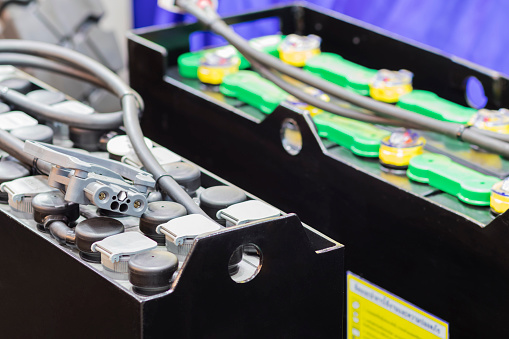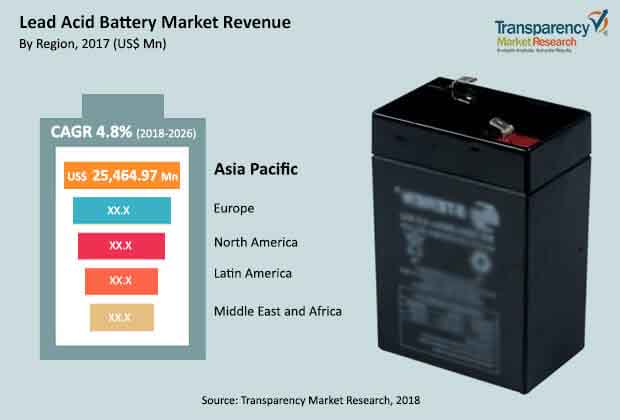
Lead Acid Battery Market: Snapshot
Lead acid batteries consist of lead-dioxide cathode, sulfuric acid solution electrolyte, and sponge metallic lead anode. During discharge, lead sulfate, water, and energy are created by a chemical reaction between lead dioxide, lead, and sulfuric acid. During charging, an external electrical charging source converts lead sulfate and water to lead, lead oxide, and sulfuric acid. Lead acid batteries are robust and less expensive. They can deliver high currents and are available in different sizes and capacities. Lead acid battery is considered as the most recycled product in the world.
Request Brochure:
https://www.transparencymarketresearch.com/sample/sample.php?flag=B&rep_id=41702
The global lead acid battery market has been segmented based on product type and application. Based on product type, the global lead acid battery market has been divided into flooded and sealed type lead acid batteries. AGM and gel are the sub-segments of the sealed type lead acid batteries. Flooded lead acid batteries are widely employed in the automotive sector. They have the least cost per ampere hour vis-à-vis any other lead acid battery. Flooded batteries are wet cells, which are available in two types: maintenance-free and serviceable. Sealed lead acid batteries are commonly known as Valve Regulated Lead Acid (VRLA) batteries. The number of plates and their thickness determine their end-use/application. They do not tend to degrade or sulfate as easily as wet cells and are considered the safest batteries to use. There are primarily two types of sealed lead acid batteries: Gel Cell (gelified electrolyte) and AGM (Absorbed Glass Matt). AGM lead acid batteries employ an absorbed glass matt process. Gel sealed lead acid batteries contain gelified electrolyte.

More Trending Reports by TMR:
The global lead acid battery market is anticipated to expand at a CAGR of more than 4.8% from 2018 to 2026, and reach around US$ 79 Bn by 2025 in terms of value.
Lead acid batteries are priced lower than their substitutes. This is the competitive advantage that lead acid batteries possess. Therefore, lead acid batteries are preferred by a large number of consumers. Low cost and reliability of these batteries is anticipated to drive their demand in the near future. The price of lead acid batteries is much lower than that of lithium-ion batteries. Therefore, the former is more attractive to consumers in developing nations. Automobile and manufacturing sectors are witnessing significant expansion. This is fueling the demand for lead acid batteries for UPS systems and inverters in several applications. Production of lead acid batteries has also increased. This, in turn, is driving the lead acid battery market. Rise in demand for stationary batteries for power backup and deep-cycle batteries for wheeled mobility such as golf cars, wheelchairs, and scissor lifts is an increasing trend in the lead acid battery market. This is boosting the market. However, lead mining extensively releases toxic smoke, including sulfur dioxide, dioxins, and dibenzofurans, into the environment. This is hazardous to life on the earth due to the contamination of soil and water. Improper and illegal disposal of lead acid batteries leads to pollution in drinking water and food produced from ingredients exposed to small and moderate levels of lead content. This is expected to restrain the market growth.
Buy Now:
https://www.transparencymarketresearch.com/checkout.php?rep_id=41702<ype=S
In January 2018, Duracell launched a 12V AGM sealed lead acid battery at the 2018 CES conference in Las Vegas, the U.S. Duracell is the U.S. based firm, which is widely known for its small alkaline batteries.
On February 13, 2018, three different lawsuits were filed against Aqua Metals for its recycling processes. However, the company announced a turnkey technical solution for the “sticky lead” problem of recycling of used lead acid batteries. This boosted the company’s share from $1.62 to close at $2.79 on February 15, 2018.
SUNLIGHT Recycling is the Lead acid Battery Recycling Branch of . In 2014, the new recycling plant was developed in co-operation with Engitec in N. Greece (Komotini), with the recycling capacity of 25,000 tons of used lead acid batteries (ULAB) per year.
Asia Pacific dominated the lead acid battery market with more than 50% share in 2016. Europe and North America followed the market in Asia Pacific in the same year.
Increase in production of vehicles, rise in requirement of uninterrupted power supply, and fast growth rate in the renewable energy sector are primarily driving the lead acid battery market in these regions. The global lead acid battery market in North America, Europe, and Asia Pacific is expected to expand at a high CAGR during the forecast period. Market share of Latin America and Middle East & Africa is also anticipated to increase, but at a slow pace, till 2025.
Key players operating in the global lead acid battery market include EnerSys, EXIDE INDUSTRIES LTD., JOHNSON CONTROLS INTERNATIONAL PLC, and GS Yuasa Corporation. Other players operating in the market include First National Battery, NorthStar., Amar Raja Batteries Ltd, HOPPECKE, Exide Technologies, HBL Power Systems Limited, C&D Technologies, Inc., East Penn Manufacturing Co., FIAMM Energy Technology S.p.A., Crown Battery Manufacturing Co., and Trojan battery Company.





